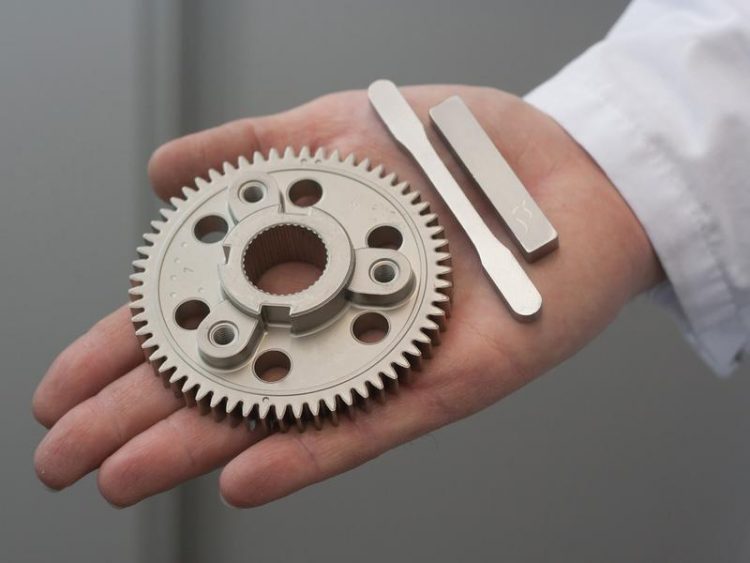New technology for powder-metallurgy moulding production

Sintered metal parts TU Vienna
Various powdered components are mixed, pressed into the required form and heated in order to produce a solid metal object of premium strength and precision – ranging from valve components and gear wheels to entire components for gearing devices. This sintering technology now plays an important role in the metalworking industry.
For decades, TU Wien has lead the field in developing this technology further, often working in partnership with some of the most important companies in the industry. A new development by TU Wien now enables carbon to be added in iron carbide form, rather than as graphite, producing denser and stronger material.
In some cases energy consumption for the production of the powder can be reduced by more than 50%. Dust production and the risk of separation of the mixture during production of the components are reduced and the material can be far better adapted to various requirements.
This new technology will be presented by TU Wien's Powder Metallurgy Team from 7 to 11 April at the Hanover Fair 2014 in Hall 6 – 'IndustrialGreenTec'.
Adding carbon wisely
To achieve high levels of strength, carbon is always used in addition to iron and other metals for the production of steel parts. For sintering, the carbon is usually added in the form of simple graphite particles. This can, however, lead to problems: “When the pressed workpiece is heated, the carbon dissolves and combines with the iron.” explains Prof. Herbert Danninger, Dean of the Faculty of Technical Chemistry at TU Wien. This causes a small cavity at the point at which the graphite grain was located, which causes the final product to be porous and decreases its strength.
“We have developed a method of adding the necessary carbon in the form of an iron compound,” reports Herbert Danninger. The iron-carbon compound – known as cementite – is relatively hard and can be difficult to compress. However, this has been made possible using a very special heat treatment method.
Better, cheaper and more environmentally friendly
Replacing graphite with cementite has many advantages: not only does it improve the properties of the material, it also drastically reduces dusting and minimises the risk of separation of the mixture during production. The new method enables the use of cheaper raw materials and also provides a very decisive advantage in terms of energy efficiency: in certain processes, only 50% of previously required energy is necessary.
At the Hanover Fair 2014, from 7 to 11 April, TU Wien will publicly present this patented invention for the first time and the Powder Metallurgy Team will also be pleased to discuss other questions or solution concepts concerning sintering technology.
In addition to the new sintering technology, TU Wien will also present further 'new materials and designed surfaces for efficiency in the use of resources' as well as various components for 'the biorefinery of tomorrow' and 'innovative analytical tests for food and feed' in Hall 6 'IndustrialGreenTec' at the Hanover Fair.
You can now register as an editor or journalist for a guided press tour through the stand of TU Wien. Please register at: forschungsmarketing@tuwien.ac.at
Image download: http://www.tuwien.ac.at/dle/pr/aktuelles/downloads/2014/pulver/
For more information, please contact:
For scientific questions:
Prof. Herbert Danninger
Institute for Chemical Technologies and Analytics
Vienna University of Technology
Getreidemarkt 9, 1040 Wien, Austria
Tel: +43-1-58801-16110
herbert.danninger@tuwien.ac.at
About the TU Wien presentation at the Hanover Fair:
Peter Heimerl
Research Marketing
Vienna University of Technology
Karlsplatz 13, 1040 Wien, Austria
Tel: +43 (0)664-605 88 3320
peter.heimerl@tuwien.ac.at
http://www.tuwien.ac.at/HM2014/ More information about TU Vienna projects at the Hanover Fair
Media Contact
All latest news from the category: HANNOVER MESSE
Newest articles

First-of-its-kind study uses remote sensing to monitor plastic debris in rivers and lakes
Remote sensing creates a cost-effective solution to monitoring plastic pollution. A first-of-its-kind study from researchers at the University of Minnesota Twin Cities shows how remote sensing can help monitor and…

Laser-based artificial neuron mimics nerve cell functions at lightning speed
With a processing speed a billion times faster than nature, chip-based laser neuron could help advance AI tasks such as pattern recognition and sequence prediction. Researchers have developed a laser-based…

Optimising the processing of plastic waste
Just one look in the yellow bin reveals a colourful jumble of different types of plastic. However, the purer and more uniform plastic waste is, the easier it is to…



